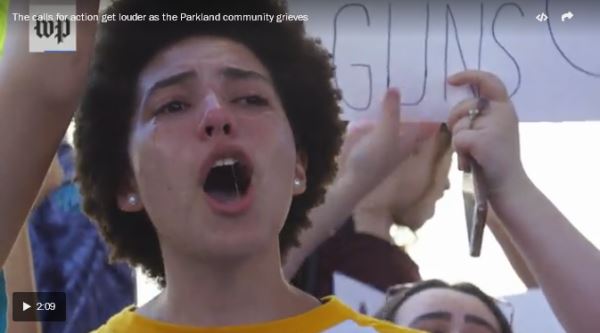In a sign that this pressure may be weighing on President Trump, the White House announcedMonday that he is “supportive” of efforts in Congress to improve background checks for gun purchases. A 77 percent majority says Congress is not doing enough to prevent mass shootings and 62 percent say the same of Trump, according to the poll. At least half feel “strongly” that Congress and the president have not taken adequate action. Majorities across party lines express frustration with Congress, while views of Trump are more divided. More than 8 in 10 Democrats and two-thirds of independents say the president is not doing enough. More than 6 in 10 Republicans say Trump is taking sufficient action to prevent mass shootings, although more than one-quarter of fellow partisans, 28 percent, say he is not.
Any legislative or policy response to the Florida school shooting is expected to be limited — neither Trump nor Republican leaders in Congress have, for instance, shown support for proposals to restrict sales of military-style assault rifles. A similar proposal was pushed by President Barack Obama and Democratic congressional leaders in 2013 but failed to advance through Congress following the shootings at Sandy Hook Elementary in Newtown, Conn.
The debate over what Congress and the president should do in response to mass shootings is once again confronting Washington after Nikolas Cruz, 19, allegedly killed 17 people at his former high school Wednesday, with authorities charging that he aimed his AR-15 assault-style rifle and fired round after round into classroom after classroom in one of the nation’s worst school shootings.
The use of high-powered semiautomatic rifles in recent mass shootings, including by Cruz, police say, and in last year’s killing of 58 concertgoers in Las Vegas, has sparked calls to reinstate the 10-year ban on assault weapons that expired in 2004.
But Americans are roughly split on this proposal, with 50 percent in support and 46 percent opposed, a stark contrast from the 80 percent support for the ban in 1994, the year it was enacted. The current level of support is little different from 51 percent in 2016.

The falloff in support for restricting assault weapons has come from all partisan groups, but has been starkest among Republicans and independents. While more than 7 in 10 Republicans and independents supported banning assault weapons in 1999, the new Post-ABC poll finds 45 percent of independents supporting it now, dropping to 29 percent among Republicans. A 71 percent majority of Democrats support such a ban.
There is also a strong partisan divide on whether stricter gun control laws could have prevented last week’s Florida shooting, closely mirroring support for such restrictions. Fully 86 percent of Democrats say stricter laws could have prevented the killings, compared with 29 percent of Republicans. Independents are squarely in between, with 57 percent saying stricter gun laws could have prevented the attack.
The killings in Florida have also revived the debate over whether teachers should be allowed to carry guns in schools — an idea DeVos, while careful not to outright endorse it, said in an interview last week with conservative radio host Hugh Hewitt should “be part of the broader, more robust conversation about how can we avoid these things in the future.”
Partisans disagree on whether allowing teachers to be armed could have stopped the attack, with 59 percent of Republicans saying it could, compared with 46 percent of independents and 23 percent of Democrats.
Parents of school-age children differ somewhat on this question. A slight 51 percent majority of parents with children under 18 who live at home say the Florida shooting could have been prevented if teachers were able to carry firearms, compared with 38 percent of Americans without young children. There is a smaller parental divide in support for banning assault weapons, a policy backed by 46 percent of parents and 51 percent of non-parents.
Americans are more unified in saying improved mental health screening and treatment could have prevented Florida’s attack, with more than three-quarters of Democrats, Republicans and independents in agreement on this question.
Asked about mass shootings more broadly, the public says by a roughly 2 to 1 margin that they reflect problems identifying and treating people with mental health problems rather than inadequate gun control laws. Fully 8 in 10 Republicans say mass shootings are mainly reflective of problems dealing with mental health issues, as do more than 6 in 10 independents. A slight majority of Democrats, 52 percent, say they mainly reflect inadequate gun laws.
The Post-ABC poll was conducted Feb. 15-18 among a random sample of 808 adults reached on cell and landline phones with a margin of sampling error of plus or minus four percentage points.
(The Washington Post)